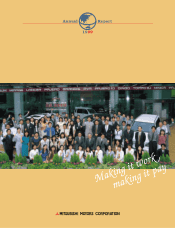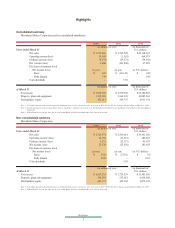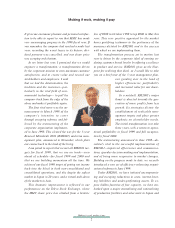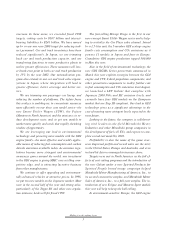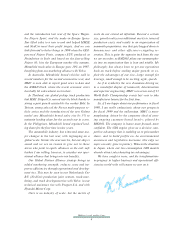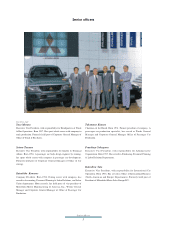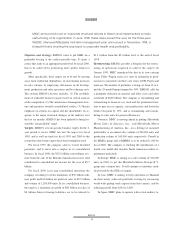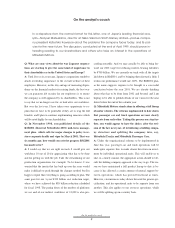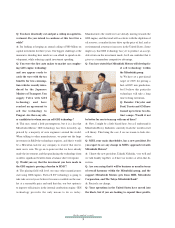Mitsubishi 1999 Annual Report Download - page 8
Download and view the complete annual report
Please find page 8 of the 1999 Mitsubishi annual report below. You can navigate through the pages in the report by either clicking on the pages listed below, or by using the keyword search tool below to find specific information within the annual report.
Objective and strategy: RM2001 seeks to put MMC on a
profitable footing at the earliest possible time. It charts a
course that leads to an appropriate profit level by fiscal 2000,
this to be achieved by generating more profits from less
growth.
More specifically, these targets are to be met by moving
away from traditional dependence on incremental increases
in sales volume, by improving efficiencies in all develop-
ment, production and sales operations and by reducing costs.
The strategy RM2001 dictates includes: (1) The establish-
ment of realizable business targets based on critical analysis
of the competition; (2) The orientation of management struc-
ture and priorities towards consolidated results; (3) Greater
emphasis on returns on capital and the shareholder. In re-
sponse to the major structural changes in the industry over
the last six months, RM2001 has been updated to bring for-
ward the "get profitable" target .
Targets: RM2001 sets out specific business targets for the 3-
year period it covers. MMC has met the targets for fiscal
1998, and is well on track for fiscal 1999 and 2000–to the
extent that some future targets have been brought forward.
For fiscal 1999, the company aims to restore dividend
payments, and to move into a surplus in its consolidated
business. In fiscal 1998, the ¥25.6 billion extraordinary rev-
enue from the sale of the Maruko transmission factory land
contributed to consolidated net income for the year of ¥5.7
billion.
For fiscal 2000, in its non-consolidated operations the
company is looking to return minimums of ¥50 billion ordi-
nary profit and ¥10 billion net profit on sales of ¥2.5 trillion
and volume of 1,200,000 units. In its consolidated business,
the target is a minimum net profit of ¥20 billion on sales of
¥4 trillion. Interest-bearing liabilities are to be reduced to
¥1.3 trillion from the ¥2 trillion level at the end of fiscal
1998.
Restructuring: RM2001 provides a blueprint for the restruc-
turing of operations required to achieve the targets. In
January 1999, MMC introduced the first in its new-concept
Smart Utility Wagon series as it starts to rationalize its prod-
uct mix to concentrate on three core series: SUW, Pajero and
minicars. The number of platforms is being cut from 13 to 6,
and the 24-model lineup trimmed by 40%. RM2001 calls for
a minimum reduction in material and labor costs and other
overheads of ¥420 billion. The company is streamlining and
rationalizing its domestic car, truck and bus production facil-
ities to pare excess capacity, raise productivity and lower the
break-even point by 15%, and is rationalizing and consoli-
dating its sales units for greater efficiencies.
Overseas, MMC is moving ahead in putting Mitsubishi
Motor Sales of America, Inc., and Mitsubishi Motor
Manufacturing of America, Inc., on a footing of sustained
profitability at an annual sales volume of 200,000 units and
production volume of 160,000 units respectively. Payroll in
the MMSA group and at MMMA is to be reduced 1,000 by
fiscal 2000. The company is studying the introduction of a
fourth core model that matches North American market re-
quirements and needs.
In Europe, MMC is aiming at a sales volume of 330,000
units in 2000, to put the Mitsubishi Motors Europe B.V.
group onto a firmer base. It will continue to introduce mod-
els powered by the GDI eco-engine.
In Asia, MMC is aiming to keep operations in Thailand
on their newly achieved profitable footing by increasing
world-wide pickup truck exports from that country, and by
reducing payroll from 4,000 to 2,800.
In Japan, MMC plans to operate with a total indirect la-
RM2001
RM2001
6
MMC announced a set of corporate structural reforms in March and implemented a major
restructuring of its organization in June 1998. These steps paved the way for the three-year
RM2001 (Renewal Mitsubishi) mid-term management plan announced in November 1998, a
blueprint that is charting the way back to corporate health and profitability.

